Saturday, May 23, 2009
Mt. Huangshan Tour (sightseeing or hiking),Huangshan in Anhui
Wednesday, May 20, 2009
What is Chinese Kung Fu?
Chinese Kung Fu
![[hlCultureType]](http://www.visitourchina.com/images/guide/culture/gongfu.jpg) What is Chinese Kung Fu?
What is Chinese Kung Fu?
Chinese Kung Fu, also known as Wushu or martial arts in China, is a kind of Chinese traditional sport and one of the most well known examples of Chinese traditional culture. It is characterized by various barehanded and armed combat techniques. Chinese Kung Fu is very rich in form and content, including Taijiquan, Qigong (breathing exercise), Neigong (internal exercise), Tongzigong (children's exercise), Houquan (Monkey's Shadow boxing), Tanglangquan (Mantis' Shadow Boxing), and a humorous one Zuiquan—performed by a drunkard. Chinese Kung Fu, which can increase energy, fitness, coordination, mental well-being, self-discipline and confidence, requires the concentrated coordination of the mind and body. There are two kind of Chinese Kung Fu—“external" and "internal" Kung Fu. It is said that "In external Kung Fu, you exercise your tendons, bones, and skin; in internal kung fu, you train your spirit your qi, and your mind."
The History and the Development of Chinese Kung Fu
The history of Chinese Kung Fu can be traced to self-defense needs, hunting activities in ancient China. In the primitive society, people lived by hunting for their food and fight against the wild beasts.
In Shang Dynasty (1600 ~1100 BC), hunting was regarded as an important measure of Kung Fu training. Then, Shǒubó Kung Fu, one example of ancient Chinese Kung Fu, appeared.
Later, in Zhou Dynasty (11th century BC~221 BC), Chinese Kung Fu developed as a kind of dancing—martial arts dancing.
In the Spring and Autumn Periods (770 BC-476 BC), great importance was attached to Chinese Kung Fu and excellent people were attracted to the sport.
In Qin Dynasty (221 BC to 206 BC) and Han Dynasties (206 B.C.–220 A.D.) martial arts dancing was very popular. During that period, innovation of Chinese Kung Fu was promoted; the Five-animal-style exercise was an example of the development of Chinese Kung Fu.
In Tang Dynasty (581 – 618), Chinese Kung Fu developed very fast, and it became a kind of examination, through which the winners were awarded and gave titles. From then on, Chinese Kung Fu was introduced to many other countries, mainly to the countries in Southeast Asia.
In Song Dynasty (960 ~1279) and Yuan Dynasties (1271 ~ 1368), the Development of Chinese Kung Fu reached the highest level.
Then in the Ming Dynasty (1368~1644) and Qing Dynasty (1644~1911), Chinese Kung Fu also developed rapidly. During the two dynasties, some schools specializing in training Chinese Kung Fu came into being. Besides, different genres of Chinese Kung Fu were integrated.
Till now, many teams and organizations of Chinese Kung Fu have been established and developed. Some of them have participated in the Olympic Games. Nowadays, Chinese Kung Fu is not only popular among Chinese, but also popular among lots of foreigners. More and more people are participating in practicing Chinese Kung Fu.
Over its long history, Chinese Kung Fu has incorporated different philosophies and ideas into its practice. It has expanded the purpose from self-defense to health maintenance and finally as method of self cultivation. In return, the ideal of Chinese Kung Fu influences the poetry, the fiction, and the film. Chinese Kung Fu is now an integral element of Chinese traditional culture.
Tuesday, May 19, 2009
Beijing Shopping , Beijing introduced the whole shopping mall
Shopping In Beijing
Beijing is a superior shopping destination. Offering a wide variety of shopping opportunities, from street markets to huge new malls full of famous brand names; there is almost nothing that you can't buy in Beijing. It is practically impossible to list all the shopping opportunities. This is just a sampling of some of the better known places. All of them are within close proximity to many of the sights you will want to see in Beijing. If you have heard about another store or mall that you would like to go to, we can arrange that also. If there is something specific you want to buy, just let us know.
Wangfujing Street, Beijing's Premier Shopping District




Hongqiao Pearl Market: This is one of the most famous and popular markets for the locals in Beijing. It is also frequented by many foreign and Chinese celebrities. Hongqiao Market is one of the best place to buy high quality Chinese pearls at very affordable prices. Of course, if pearls are not on your shopping list, there are also plenty of other inexpensive and interesting goods on the lower floors. If you are interested in bringing home some toys, kites, etc. for your young family members; try Toys City, the building directly behind the main building. Bargaining is almost an art here.

Sanlitun Yashow Clothing: Five floors of virtually anything you might need or want, this store is a favorite with expats and visitors. If you are looking for shoes, purses, suitcases, coats, jewelry, or toys, this is the place you might want to try. Tailors can be found on the third floor. Bargaining is expected here.



New Qianmen Market : Qianmen Dajie is the oldest traditional market street in Beijing and is located directly south of Tian'anmen Square and Qianmen Gate. Renovated for the Olympics, Qianmen Market Street (Qianmen Dajie) has a history of over 500 years. An east-west lane opening on the western side of Qianmen is the famous Dashilan Jie. Many of the shops here are hundreds of years old, and are a good place to shop for silk, Chinese medicine, and other traditional Chinese goods. Consider eating at one of the famous, old restaurants.
Beijing Wangfujing Street,Take you into Wangfujing shoppping Street
Beijing Wangfujing Street,Take you into Wangfujing shoppping Street
Wangfujing is now considered the central heart of the city. Certainly from Wangfujing all areas of Beijing are easily accessible. Wangfujing is a fairly long street. A walk from end to end would take you about 30 minutes, and that's without looking at any shops.
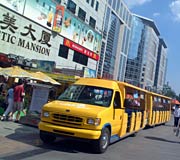
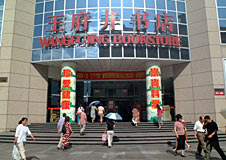
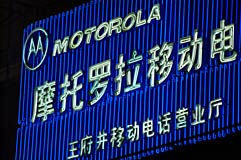
The street has two major shopping malls, one of which, Oriental Plaza, sprawls a further 2 blocks to the east (and another 15 minute walk). Wangfujing street is also home to a number of large department stores, souvenir stores, and whole side streets full of food stalls, Chinese painting stores and other goodies.
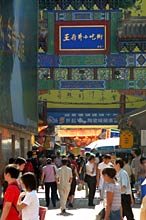
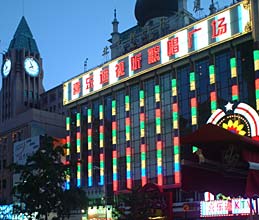
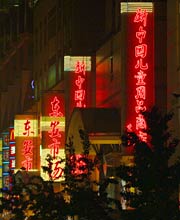
It is also home to one of the biggest book stores in Beijing, (Wangfujing Bookstore) and probably the largest outdoor TV screen in Beijing.
At night, when Wangfujing street turns on its ever increasing number of neon advertising signs, even more crowds flock to soak up the atmosphere. The neons can now be compared to those of any major city in the world and are very popular with the tourists, especially those coming from less developed parts of China. Most shops stay open till around 9pm and sometimes an impromptu night market
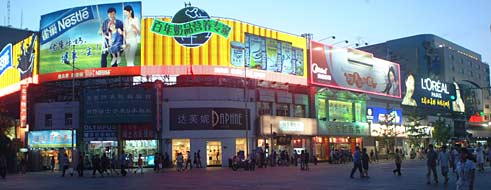
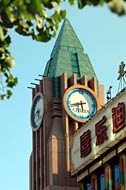
Wangfujing Shopping Street and Night Food Market
Wangfujing Street
| Xindongan Department Store, Wangfujing Street |
 |  |  |
Wangfujing Street has a history of over 700 years. The first residences built here were that of aristocrats and princesses. An important sweet water well was also located on this street. The name of the street came about as a combination of Wangfu (meaning aristocratic residence) and jing (meaning well). Wangfujing Street has also been an important commercial street for hundreds of years.
| Looking South, Across the Street From Oriental Plaza |
Pedestrian friendly, Wangfujing Street is Beijing's premier shopping street. New malls stand side by side age-old shops. Try Sun Dong'an Plaza at the north end of the street and Oriental Plaza on the south, if you are looking for modern shopping malls carrying the latest in world-famous brands. Stroll Wangfujing Street, checking out the small, specialized stores that have been selling good here for more than 100 years.
| Oriental Plaza, Wangfujing Street |
|
|
|
|
|
|
|
|
Beijing Hutong with Rickshaw, Great Bell Museum, Drum Tower
This day Beijing tour begins at 08:30am and ends at around 5:00pm. Please get everything ready before our English-speaking guide meets you in the lobby of the hotel where you stay. It’s about 20 minutes driving to the first stop of the main attractions, Hutong. 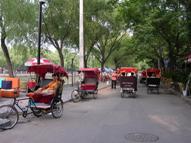
As you might have known, one of the unique features of Beijing is its numerous Hutongs, which means small lanes. The life of ordinary people in these lanes contributes greatly to the charm of this ancient capital. In these small lanes, you will find many siheyuan, or quadrangles that are the living quarters of ordinary Beijing locals. Beijing’s Hutongs are not only an appellation for the lanes but also a kind of architecture. It’s the living environment of ordinary Beijing locals. It reflects the vicissitude of society. Most of the Hutongs look almost the same with grey walls and bricks. There are often four to ten families with 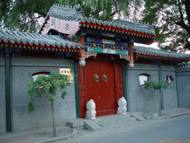 an average of 20 people sharing the rooms of one courtyard complex. The main attraction of Hutong life is a friendly and interpersonal communication. Children living in one courtyard play together and grow up like one family. For the elderly, the charm comes from each other’s company.
an average of 20 people sharing the rooms of one courtyard complex. The main attraction of Hutong life is a friendly and interpersonal communication. Children living in one courtyard play together and grow up like one family. For the elderly, the charm comes from each other’s company.
Around 09:00am, you will be arriving in the square between the Great Bell Museum and the Drum Tower. We would like to offer Beijing Hutong tour with rickshaw from here. You will observe and learn how Beijing locals have their real life every day. The rickshaw puller and our English-speaking guide will take you to a local family for a home visit. Together with the hostess or host, you can go to the local market for lunch food, such as vegetables, meat, etc. The hostess or host will teach you how to make the dumplings or noodles. Obviously you will enjoy this Chinese lunch made by yourselves. Four hours are needed to experience Beijing Hutong local real life. 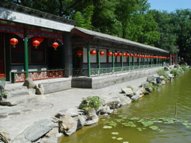
After lunch if time permits, you will go for a visit to a kindergarten, the old folks’ home or a hospital.
In the afternoon, you will be taken for a visit to the mansion of Prince Gong of Qing Dynasty, which was the Residence of the Last Qing Emperor’s Father. The mansion is the most exquisitely decorated and best preserved among the princes' mansions in Beijing, and beside the residence there is also a large garden. The mansion cons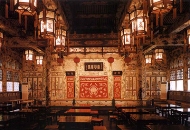 ists of two parts: living quarters and the garden, covering 56,000 square meters. The living quarters run along three axes - central, eastern and western, altogether having 1,000 rooms. People can imagine the grandeur from its green glazed-tile roofs. The garden of Prince Gong's Mansion covers 25,000 square meters, with artificial rockeries, covered corridors and pavilions. It is said the Grand View Garden described in the novel "A Dream of Red Mansions" was modeled after this garden.
ists of two parts: living quarters and the garden, covering 56,000 square meters. The living quarters run along three axes - central, eastern and western, altogether having 1,000 rooms. People can imagine the grandeur from its green glazed-tile roofs. The garden of Prince Gong's Mansion covers 25,000 square meters, with artificial rockeries, covered corridors and pavilions. It is said the Grand View Garden described in the novel "A Dream of Red Mansions" was modeled after this garden.
Not far from the mansion of Prince Gong is the Former Reside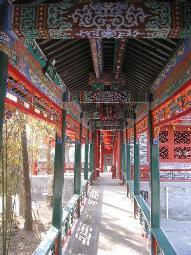 nce of Soong Ching Ling, late Honorary Chairman of the People's Republic of China. Led by the rickshaw puller and our English-speaking guide, you come to Yin Ding Bridge with a ride past the Former Residence of Soong Ching Ling. After a short view of Shichahai, you can come to the bar street for a drink. This tour will end with the visit to the Drum Tower. With sixty-nine steps climbing to the Drum Tower, you may happen to see the performance of beating drums every half hour. After a short view of Great Bell Museum, both old and modern Beijing, an exciting Yangge, which is a popular rural folk dance is arranged.
nce of Soong Ching Ling, late Honorary Chairman of the People's Republic of China. Led by the rickshaw puller and our English-speaking guide, you come to Yin Ding Bridge with a ride past the Former Residence of Soong Ching Ling. After a short view of Shichahai, you can come to the bar street for a drink. This tour will end with the visit to the Drum Tower. With sixty-nine steps climbing to the Drum Tower, you may happen to see the performance of beating drums every half hour. After a short view of Great Bell Museum, both old and modern Beijing, an exciting Yangge, which is a popular rural folk dance is arranged.
We would like to end this day tour with the transfer back to your hotel at around 5:00pm. We hope that this day tour arrangement just fits your need. We look forward to hearing from you.
Beijing Private Tours,Beijing Bicycling tour in Beijing
Beijing Bike Tours
( Touch Beijing by Bike )

Bicycling is one of the best ways to visit Beijing. It is a safe, healty, convenient, economical and environmentally friendly means of travel and transportation. In China, it is also a kind of life style for the people. Due to the unique bicycle culture, China is nicknamed the "Bicycle Kingdom". Beijing is undeniablly the king of the bike kingdom best manifested by the top song singed by Katie Melua titled "Nine Million Bicycles in Beijing". The song also tells the westerners feeling about the bikes in Beijing. The bikes to Chinese people are what the cars to the westerns. They are more than means of transportations, they are a way of life, a kind of Chinese culture and people's friends. People at all ages love bikes in China. Cyclists are therefore given high priority in the traffic. In Beijing you will find many bicycle paths. It is said that Pu Yi, the Last Emperor of the Qing Dynasty loved bicycles so much that he went so far as to order his servants to saw off the thresholds of the gates to make it more convenient for him to ride his bicycle. Do you have the fancy idea of riding a nice bike shoulder to shoulder with the locals to see the imperial city, and explore the Hutongs? No Bike No Beijing!

Bike Beijing is happy to welcome you to the city of Beijing and to everything Beijing has to offer. Bike Beijing offers the quality bike tours for the English-speaking tourists and we are ready to show you Beijing as you've never seen it before! We offer you the best bike tours, resourceful and entertaining tour guides and a lot of fun. We are the bike travel experts. We have the know-how. After many years of escorting hundreds of tourists, we have become the benchmark. Enjoy our bicycle tours of Beijing (day and night, half day or full day). Our routes have been carefully planned so that you do not encounter much traffic, still allowing you the opportunity to see and experience as many things as possible en route. Our Day Guided Bike Tour is the perfect tour for both those new to the city and Beijing veterans. For the beginners, this tour will offer you a fantastic orientation. For the veterans, we are confident you'll learn new facts and stories behind Beijing that you’ve never heard. And we are sure you'll both agree that biking is the best way to see Beijing --"King of Bikes"! Bike Beijing - Bicycle Kingdom Tours & Rentals operates one of the largest fleets of cycles in Beijing, offering bike hire and short guided tours around central Beijing.
Monday, May 18, 2009
beijing tour to Great Wall at Simatai section
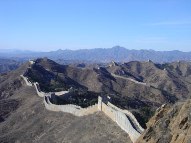 nd 6:00pm. Please get everything ready before our English-speaking guide comes and meets you in the lobby of the hotel where you stay. It’s about 3 hours driving to the Great Wall at Simatai section.
nd 6:00pm. Please get everything ready before our English-speaking guide comes and meets you in the lobby of the hotel where you stay. It’s about 3 hours driving to the Great Wall at Simatai section.Simatai, located in the north of Miyun County, 120km northeast of Beijing, holds the access to Gubeikou, a strategic pass in the eastern part of the Great Wall. Originally built during the Northern Qi dynasty (550-577) and rebuilt in the Hongwu years of the Ming dynasty by Qi Jiguang, this section of Great Wall is the only part of the Great Wall which keeps the original features of the Ming dynasty Great Wall.
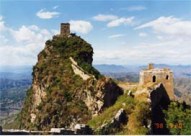
Simatai Great Wall is 5.4km long with 35 beacon towers. Ingeniously conceived and uniquely designed, this section of Great Wall, inimitable and diversified, has incorporated the different characteristics of each section of the Great Wall. Professor Luo Zhewen, a famous specialist of Great Wall, says: "The Great Wall is the best of the Chinese buildings, and Simatai is the best of the Great Wall."
Hanging precariously onto the Yanshan Mountain, Simatai Great Wall is known for its steepness, ingenuity and uniqueness.
Steepness: built on the precipitous mountains, there are many places that
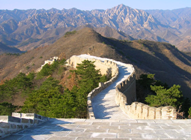 are unmatched among other sections of Great Wall. The Heavenly Ladder and the Sky Bridge are particularly dangerous that they could make everyone on them tremble with fear.
are unmatched among other sections of Great Wall. The Heavenly Ladder and the Sky Bridge are particularly dangerous that they could make everyone on them tremble with fear. Ingenuity: compares with other sections of Great Wall, Simatai is densely dotted with beacon towers, in which the nearest two are only 43.8m apart and the farthest of 600m. While in other sections, beacon towers were built at intervals of 500m. In this section, the walls are in single, double and trapeziform forms and the watchtowers are round or oblate in shape and composed of two or three floors. Even the roofs of the tower are also diverse: some are flat, some cymbiform and some domical shapes.
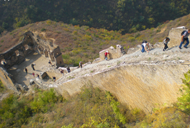
Uniqueness: built on the mountain ridge with limestone caves under it, this section of wall is imposing and unique among other sections. More interesting is that there are two springs called Mandarin Duck Springs at the foot of the Great Wall. The east one is cold, while the west warm. The two springs join into one lake. Then half of the lake is cold and the other half is warm. In winter, hot steam rises from the lake, forming a marvelous spectacle in this area.
Simatai Great Wall is separated into two parts by a valley, namely the east part and west part. The west part appears gentle with 20 well-preserved watch towers dotting here and there. Comparing with the west part, the east part i
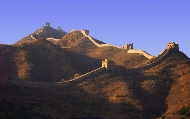 s somewhat steep and cliffy. 15 watchtowers densely scattered on the thousand-meter-high peaks, adding enchanting views to the wall. In this part, the main attractions include Watching Beijing Tower, Fairy Tower, Heavenly Ladder and Sky Bridge.
s somewhat steep and cliffy. 15 watchtowers densely scattered on the thousand-meter-high peaks, adding enchanting views to the wall. In this part, the main attractions include Watching Beijing Tower, Fairy Tower, Heavenly Ladder and Sky Bridge.Watching Beijing Tower: with an elevation of 986 meters, it is regarded as the summit of Simatai section of Great Wall as well as the highest cultural relics in Beijing. Mounting the tower at night, one can see lights shimmering faintly in downtown Beijing. More interesting is that the bricks used to built the walls here even stamped with the date on which they were made and the code numbers of the armies that ma
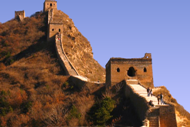 de them.
de them. Fairy Tower: with a sculpture of twin lotus flowers above the arched doors, it is the most beautiful of all towers and is known for its exquisite architecture. Legend goes that it was the dwelling place for an antelope reincarnated in the form of an angel who fell in love with a shepherd.
Heavenly Ladder: leaning against a mountain slope with a 90-degree gradient, it is the way to the Watching Beijing Tower and the Fairy Maiden Tower. Stretching upward along the abrupt mountain ridges, the narrowest part is just half a meter wide.
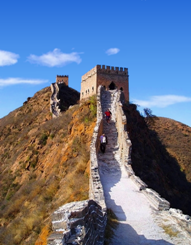
Sky Bridge: with a cabined width of mere 40 centimeter, it is really a 100-meter-long way, connecting the Fairy Tower to Watching Beijing Tower. Only brave man can pass through this bridge.
Noted by the UNESCO as one of the World Cultural Heritages, Simatai Great Wall is the famous scenic spot for traveling, exploration and inspection. Now, this site is open to visitors at home and abroad.
A restaurant take-out lunch will be served. It is included in the given price.
This day tour ends with the transfer back to your hotel at around 6:00pm. We hope that this day tour arrangement just fits your need. We look forward to hearing from you.
beijing tour to Great Wall at Badaling section, Ming Tombs, Sacred Road
This day Beijing tour begins at 08:30am and ends at around 5:00pm. Please get everything ready before our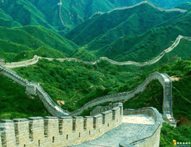 English-speaking guide comes and meets you in the lobby of the hotel where you stay. It’s about one and half hours driving to the first stop of the main attractions, the Great Wall at Badaling section.
English-speaking guide comes and meets you in the lobby of the hotel where you stay. It’s about one and half hours driving to the first stop of the main attractions, the Great Wall at Badaling section.
Badaling means "giving access to every direction", the name itself suggests its strategic importance. Badaling Great Wall lies in Yanqing County, northwest of Beijing. It covers five counties and one district, namely: Miyun, Huairou, Pinggu, Yanqing and Changping County and Mentougou District. Badaling Great Wall was the best-preserved part of the Ming Great Wall. Here, the wall averages 7.8 meters high, 6.5 metres wide of the base, and 5.8 meters at the top. The wall was designed to allow five horsemen or ten soldiers to march side by side along the wall. The flights of stairs up to the outer wall are 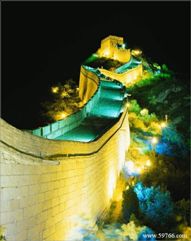 fairely widely spaced. For every few hundred meters, you can see a watchtower. Also, the wall of this section was built of giant rocks and bricks of similar size. It was faced with stone, and the inside was filled with earth and rubber, therefore, Badaling Great Wall was also regarded the strongest section of the Ming Great Wall. Two hours are needed for visiting the Great Wall at Badaling section.
fairely widely spaced. For every few hundred meters, you can see a watchtower. Also, the wall of this section was built of giant rocks and bricks of similar size. It was faced with stone, and the inside was filled with earth and rubber, therefore, Badaling Great Wall was also regarded the strongest section of the Ming Great Wall. Two hours are needed for visiting the Great Wall at Badaling section.
12:30pm, it is time for lunch when you finish morning half day tour. We would like to offer Beijing day tour with lunch in a local restaurant, which is included in the given price. We also consider that in this way you can learn a lot more about Chinese cuisines during your stay in China. 2 hours are needed for having lunch and driving to the next stop, the Ming Tombs, and Sacred Road.
The Ming Tombs are located 50 kilometers to the nort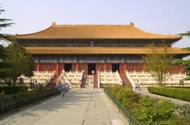 hwest of downtown Beijing. The burial ground of 13 emperors of the Ming Dynasty (1368-1644) is embraced by mountains on three sides and opening to a flat basin on the south. Mangshan and Hushan mountains rise on either side. The Wenyu River flows to the northwest. The whole area of 40 square kilometers is covered with ancient pine and cypress trees. Changling, the oldest mausoleum in the center of the burial complex on Tianshou Mountain, was built in 1409 and Siling, the last mausoleum of the Ming Tombs, was built in 1644, 200 years after the first one. It was the most costly construction project with the longest time in the construction of imperial burial grounds in China. In those days the area with a circumference of several dozen kilometers was tightly guarded, giving it a mysterious atmosphere.
hwest of downtown Beijing. The burial ground of 13 emperors of the Ming Dynasty (1368-1644) is embraced by mountains on three sides and opening to a flat basin on the south. Mangshan and Hushan mountains rise on either side. The Wenyu River flows to the northwest. The whole area of 40 square kilometers is covered with ancient pine and cypress trees. Changling, the oldest mausoleum in the center of the burial complex on Tianshou Mountain, was built in 1409 and Siling, the last mausoleum of the Ming Tombs, was built in 1644, 200 years after the first one. It was the most costly construction project with the longest time in the construction of imperial burial grounds in China. In those days the area with a circumference of several dozen kilometers was tightly guarded, giving it a mysterious atmosphere.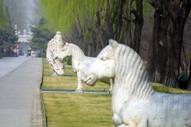
In the front part of the imperial necropolises, there usually is a Sacred Way (or Divine Road), which means the road leading to heaven. The Emperor, known as the Son of the Heaven, who came from Heaven to his country through the Sacred Way, also deservedly would return to Heaven through this road. The road is often lined with stone statues, which are important decorations of the mausoleum. These statues are usually 12 human figures (including the general, civil officials and meritorious officials) and 24 animals, which are lion, camel, elephant, xiezhi (a mythological unicorn), qilin (one of the four "divine animals, the other three are dragon, phoenix and tortoise), and horse. There are 4 of each of these animals: two standing and two squatting with different meanings. Lion symbolizes awesome solemnity because of their ferocity. Camel and elephant are meant to suggest the vastness of the 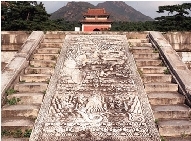 territory controlled by the court, because they are dependable transport in desert and tropics. Xiezhi was put there to keep evil spirits away, because it was believed to possess the sixth sense to tell right and wrong. If two men fight, a xiezhi would gore the wicked one. Qilin, an auspicious symbol, was placed on two sides. Horse, as the emperor's mount, is absolutely indispensable. It is said that these animals is supposed to change guard at midnight.
territory controlled by the court, because they are dependable transport in desert and tropics. Xiezhi was put there to keep evil spirits away, because it was believed to possess the sixth sense to tell right and wrong. If two men fight, a xiezhi would gore the wicked one. Qilin, an auspicious symbol, was placed on two sides. Horse, as the emperor's mount, is absolutely indispensable. It is said that these animals is supposed to change guard at midnight.
This day tour ends with the transfer back to your hotel at around 5:00pm. We hope that this day tour arrangement just fits your needs and interests. We look forward to hearing from you.



